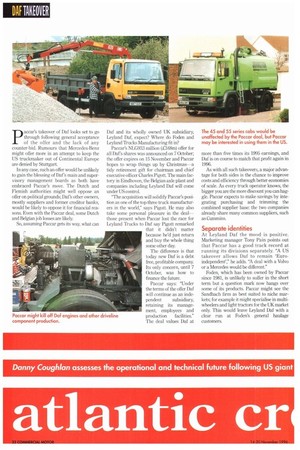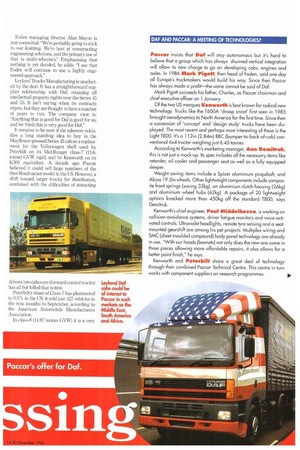p accar's takeover of Daf looks set to go through following
Page 34

Page 35

If you've noticed an error in this article please click here to report it so we can fix it.
general acceptance of the offer and the lack of any counter-bid. Rumours that Mercedes-Benz might offer more in an attempt to keep the US truckmaker out of Continental Europe are denied by Stuttgart.
In any case, such an offer would be unlikely to gain the blessing of Daf's main and supervisory management boards as both have embraced Paccar's move. The Dutch and Flemish authorities might well oppose an offer on political grounds; Oaf's other owners, mostly suppliers and former creditor banks, would be likely to oppose it for financial reasons. Even with the Paccar deal, some Dutch and Belgian job losses are likely.
So, assuming Paccar gets its way, what can Daf and its wholly owned UK subsidiary, Leyland Daf, expect? Where do Foden and Leyland Trucks Manufacturing fit in?
Paccar's NLG933 million (k348m) offer for all Oaf's shares was announced on 7 October; the offer expires on 15 November and Paccar hopes to wrap things up by Christmas—a tidy retirement gift for chairman and chief executive officer Charles Pigott. The main factory in Eindhoven, the Belgian axle plant and companies including Leyland Daf will come under US control.
"The acquisition will solidify Paccar's position as one of the top three truck manufacturers in the world," says Pigott. He may also take some personal pleasure in the deal— those present when Paccar lost the race for Leyland Trucks to Daf say Pigott remarked that it didn't matter because he'd just return and buy the whole thing some other day.
The difference is that today new Daf is a debt free, profitable company. Its only concern, until 7 October, was how to finance the future.
Paccar says: "Under the terms of the offer Daf will continue as an inde pendent subsidiary, retaining its management, employees and production facilities." The deal values Daf at
more than five times its 1995 earnings, and Daf is on course to match that profit again in 1996.
As with all such takeovers, a major advantage for both sides is the chance to improve costs and efficiency through better economies of scale. As every truck operator knows, the bigger you are the more discount you can haggle. Paccar expects to make savings by integrating purchasing and trimming the combined supplier base: the two companies already share many common suppliers, such as Cummins.
At Leyland Daf the mood is positive. Marketing manager Tony Pain points out that Paccar has a good track record at running its divisions separately. "A US takeover allows Daf to remain 'Euroindependent'," he adds. "A deal with a Volvo or a Mercedes would be different."
Foden, which has been owned by Paccar since 1981, is unlikely to suffer in the short term but a question mark now hangs over some of its products. Paccar might see the Sandbach firm as best suited to niche markets; for example it might specialise in multiwheelers and light tractors for the UK market only. This would leave Leyland Daf with a clear run at Foden's general haulage customers.
Foden managing director Alan Mayne is non-committal: "We're probably going to stick to our knitting. We're best at constructing engineering solutions, and the primary use of that is multi-wheelers." Emphasising that nothing is yet decided, he adds: "I see that Foden will continue to use a highly engineered approach."
Leyland Trucks Manufacturing is unaffected by the deal. It has a straightforward supplier relationship with Daf, retaining all intellectual property rights over the Series 45 and 55. It isn't saying when its contracts expire, but they are thought to have a number of years to run. The company view is: "Anything that is good for Daf is good for us, and we think this is very good for Daf."
It remains to be seen if the takeover rekindles a long standing idea to buy in the Mayflower-pressed Series 45 cab as a replacement for the Volkswagen shell used by Peterbilt on its Mid-Ranger class-7 (13.6tonne) GVW rigid, and by Kenworth on its K300 equivalent. A decade ago Paccar believed it could sell large numbers of the then Roadrunner model in the US. However, a shift toward larger trucks for distribution, combined with the difficulties of attracting drivers into cabovers (forward-control trucks) has all but killed that notion.
Peterbilt's share of Class-7 has plummeted to 0.5% in the US: it sold just 427 vehicles in the nine months to September, according to the American Automobile Manufacturers Association.
In class-8 (14.97 tonnes GVW) it is a very
Paccar insists that Daf will stay autonomous but it's hard to believe that a group which has always shunned vertical integration will allow its new charge to go on developing cabs, engines and axles. In 1986 Mark Pigott, then head of Foden, said one day all Europe's truckmakers would build his way. Since then Paccar has always made a profit—the same cannot be said of Daf.
Mark Pigott succeeds his father, Charles, as Paccar chairman and chief executive officer on 1 January.
Of the two US marques Kenworth is best known for radical new technology. Trucks like the T600A 'droop snoot' first seen in 1985 brought aerodynamics to North America for the first time. Since then a succession of 'concept' and 'design study' trucks have been displayed. The most recent and perhaps most interesting of these is the Light 1800. It's a 112in (2.84m) BBC (bumper-to-back-of-cab) conventional 6x4 tractor weighing just 6.45 tonnes According to Kenworth's marketing manager, Ann Demitruk, this is not just a mock-up. Its spec includes all the necessary items like retarder, oil cooler and passenger seat as well as a fully equipped sleeper.
Weight saving items include a Spicer aluminium propshaft, and Alcoa 19.5in wheels. Other lightweight components include composite front springs (saving 33kg), an aluminium clutch housing (26kg) and aluminium wheel hubs (62kg). A package of 20 lightweight options knocked more than 450kg off the standard 1800, says Demitruk.
Kenworth's chief engineer, Paul Middelhoven, is working on collision-avoidance systems, driver fatigue monitors and voice activated controls. Ultraviolet headlights, remote tyre sensing and a seatmounted gearshift are among his pet projects. Multiplex wiring and SMC (sheet moulded compound) body panel technology are already in use. "With our hoods (bonnets) not only does the new one come in three pieces allowing more affordable repairs, it also allows for a better paint finish," he says.
Kenworth and Peterbilt share a great deal of technology through their combined Paccar Technical Centre. This centre in turn works with component suppliers on research programmes.
















































































































